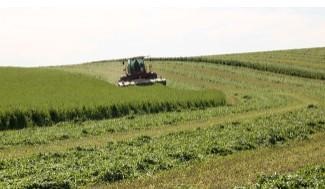By Mike Rankin

Here we go — the start of another growing season. In some areas of the U.S., the initial cutting of alfalfa is underway; for others, it is near, while some are just starting to watch the first signs of growing plants.
The initial spring cutting of alfalfa can make or break a harvest season. It’s a fascinating study of how forage quality can change ever so quickly, or how it may change at a tortoise-like pace.
Why?
No cutting of alfalfa grows under the environmental conditions offered by spring. Early on, temperatures are mostly cool, which is good news from a forage quality standpoint. As the march toward harvest maturity continues, the possible weather scenarios span the TV weatherman’s vocabulary.
The range of environmental conditions makes it difficult to gauge forage quality. Calendar dates are useless, as is phenotypic maturity stage. Relative forage quality (RFQ) can be as much as 100 points different from year-to-year on the same date; the same can be said for forage quality at a given stage of maturity.
To be sure, Mother Nature is calling the shots on forage quality when it comes to first cutting. Hot and wet brings much different results than cool and dry. Further, environmental conditions change from day-to-day more in the spring than at any other point in the growing season. This explains the fickle nature of first cutting. It also explains why it’s important to pay attention and monitor forage quality in the spring more so than any other cutting.
First-cut fiber digestibility can be the best of the season; those mostly cool days and nights are the hay producer’s friend. Once warm to hot weather sets in, or if wet weather delays the harvest, fiber digestibility can quickly move from the best to the worst of the year. This is true for pure alfalfa stands and even truer for alfalfa-grass stands.
The rate of fiber digestibility decline is unmatched by any other alfalfa cutting. This means that the harvest window is usually smaller, unless extended cool weather prevails. Here’s where new alfalfa genetics that can lower lignin content and raise neutral detergent fiber digestibility (NDFD) by as much as 15 percent will help widen this window.
No cutting of alfalfa offers the opportunity for high yields more than the first. In fact, it usually comprises the highest percentage of total-season yield compared to subsequent harvests.
Just as forage quality changes both between years and within a given year, so does alfalfa yield change more dramatically than any other cutting. Estimates are that alfalfa packs on 100 to 150 pounds of dry matter per acre per day during the late-vegetative to late-bud stages. In five days, dry matter yield jumps 1/4 to over 1/3 ton per acre. The yield x quality tradeoff is never so in play as it is with first cutting.
Click here to see more...